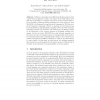Free Online Productivity Tools
i2Speak
i2Symbol
i2OCR
iTex2Img
iWeb2Print
iWeb2Shot
i2Type
iPdf2Split
iPdf2Merge
i2Bopomofo
i2Arabic
i2Style
i2Image
i2PDF
iLatex2Rtf
Sci2ools
EPEW
2005
Springer
2005
Springer
A Compositional Operational Semantics for OWL-S
Software composition via workflow specifications has received a great deal of attention recently. One reason is the high degree of fit with the encapsulation of software modules in service-oriented fashion. In the Industry, existing workflow languages have been merged to form WS-BPEL, the Business Process Execution Language for Web Services. In the Research community OWL-S, a ontology for web services, has been submitted for standardisation alongside OWL, the Web Ontology Language in which it is expressed. The OWL-S Process Model is based on an abstraction of the common features of industrial workflow languages. On the one hand, WS-BPEL has only informal semantics; on the other, the type of semantics given to ontology-based work tends to be structural rather than computationally oriented. As a result the semantics developed for DAML-S, which led to OWL-S, are still deficient in some regards. In this paper we shall survey the existing semantics and introduce a novel semantics for ...
| Added | 27 Jun 2010 |
| Updated | 27 Jun 2010 |
| Type | Conference |
| Year | 2005 |
| Where | EPEW |
| Authors | Barry Norton, Simon Foster, Andrew Hughes |
Comments (0)

